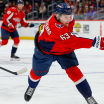Following the Capitals tough loss to the Calgary Flames on Nov. 20, head coach Barry Trotz made a few changes to his lineup, most notably putting Alex Ovechkin, Nicklas Backstrom and Tom Wilson on his top line. While reuniting Ovechkin and Backstrom generated headlines, the unsung player in that trio has been Tom Wilson, who is putting together his best offensive season as an NHL player.
Wilson discovers new role on Capitals top line
Wilson's development has been steady over the course of his career, going from a top prospect to a fourth-line player to now playing on Washington's top line.



















